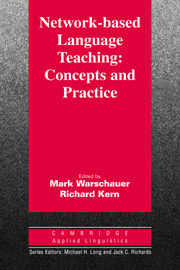Book contents
- Frontmatter
- Contents
- List of contributors
- Series editors' preface
- Preface
- 1 Introduction: Theory and practice of network-based language teaching
- 2 Sociocollaborative language learning in Bulgaria
- 3 On-line learning in second language classrooms: An ethnographic study
- 4 Negotiation in cyberspace: The role of chatting in the development of grammatical competence
- 5 Writing into change: Style shifting in asynchronous electronic discourse
- 6 Computers and collaborative writing in the foreign language curriculum
- 7 Networked multimedia environments for second language acquisition
- 8 An electronic literacy approach to network-based language teaching
- 9 Task-based language learning via audiovisual networks: The LEVERAGE project
- 10 Is networked-based learning CALL?
- Name index
- Subject index
8 - An electronic literacy approach to network-based language teaching
Published online by Cambridge University Press: 05 October 2012
- Frontmatter
- Contents
- List of contributors
- Series editors' preface
- Preface
- 1 Introduction: Theory and practice of network-based language teaching
- 2 Sociocollaborative language learning in Bulgaria
- 3 On-line learning in second language classrooms: An ethnographic study
- 4 Negotiation in cyberspace: The role of chatting in the development of grammatical competence
- 5 Writing into change: Style shifting in asynchronous electronic discourse
- 6 Computers and collaborative writing in the foreign language curriculum
- 7 Networked multimedia environments for second language acquisition
- 8 An electronic literacy approach to network-based language teaching
- 9 Task-based language learning via audiovisual networks: The LEVERAGE project
- 10 Is networked-based learning CALL?
- Name index
- Subject index
Summary
Introduction
Since the early 1990s, English-language teaching professionals have tried a variety of ways to make use of the Internet to promote language learning and practice. These range from the creation of self-access on-line quiz collections to the use of authentic on-line materials as input for contentbased projects and activities (Hegelheimer, Mills, Salzmann, & Shetzer, 1996).
However, the Internet is much more than just a teaching tool. It is becoming one of the primary media of literacy and communication practices. The estimated number of worldwide users of the Internet topped 130 million in August 1998 (Nua Ltd., 1998) and continues to grow at a rate of 40%-50% a year, with growth rates in China, Indonesia, and other developing countries as great as or greater than in the United States (Glave, 1998). E-mail is now surpassing face-to-face and telephone conversation as the most frequently used communication tool in certain business sectors (American Management Association International, 1998), while Internet-based publishing and collaboration are transforming scientific research (Harnad, 1991). Meanwhile, students of all ages must learn to find, share, and interpret on-line information as part of a necessary shift from just in case to just in time learning (Lemke, 1998). Even in the personal sphere, the Internet has become a major arena for entertainment and socializing in the United States and other developed countries. Thus, it is no exaggeration to say that the development of literacy and communication skills in new on-line media is critical to success in almost all walks of life.
Information
- Type
- Chapter
- Information
- Network-Based Language Teaching: Concepts and PracticeConcepts and Practice, pp. 171 - 185Publisher: Cambridge University PressPrint publication year: 2000
Accessibility standard: Unknown
Why this information is here
This section outlines the accessibility features of this content - including support for screen readers, full keyboard navigation and high-contrast display options. This may not be relevant for you.Accessibility Information
- 73
- Cited by
